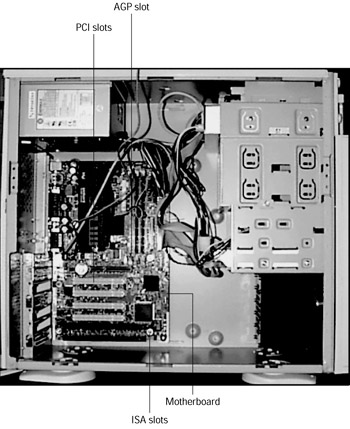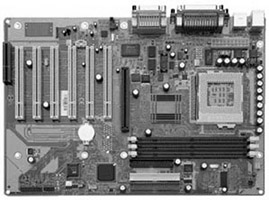Before you purchase an external device to add to your computer, you want to be sure that you have a plug available for the device. If you buy a modem that hooks into a serial port, for example, you must have a serial port available into which to plug this device. If you want to buy speakers or a camera that hooks into the USB port, your computer must have an available USB port. Let's discuss some of the different types of plugs you might encounter and what kinds of devices might plug into them:
• Power: The power port is used for one thing only, to plug the PC into the wall socket for power. No devices are ever hooked into the power port.
• Parallel printer port: Also known as the LPT1 port, the parallel printer port is generally used to connect a parallel printer. You also can plug some portable devices, such as Zip drives, into the parallel port. On the back of the computer, the parallel port generally contains 25 little sockets and the parallel cable has 25 pins on its plug. The plug itself is often referred to as a DB25.
• Serial port: The serial port is used primarily for communications devices, such as modems. Some mice and other devices can also plug into that port. The plug on a serial port is usually a DB9. (It has nine pins on the male plug and nine sockets on the female plug.) Occasionally, a PC will have a 25-pin serial port that looks like a parallel port. The serial port on the back of the PC usually is male (has pins), however, and the plug itself is female.
• USB ports: Available only in computers made after 1997, the universal serial bus (USB) port offers the ultimate in Plug-and-Play convenience. Typically, you can plug the device into the port and start using it. Common hardware devices that use the USB port include cameras, scanners, and speakers.
• SCSI (not shown): SCSI (pronounced scuzzy) stands for Small Computer System Interface. Unlike other components, SCSI devices can be daisy chained, meaning you can plug several devices into a single plug. The first device connects to the plug, the second device connects to the first device, the third device plugs into the second device, and so forth. Conventional SCSI supports up to seven devices on a single plug. Ultra Wide SCSI supports up to 15 devices.
• Speakers, microphone, line out: If your computer has sound capability, you probably have a plug for a microphone, a plug for speakers, and perhaps Line In and Line Out plugs for connecting stereos and other audio equipment. There may also be a separate port for digital sound, into which you would plug digital speakers.
• Game port: The game port plug is used to connect joysticks and other input devices. On most PCs, this plug is near the plugs for the speakers and the microphone. The port resembles the serial and parallel ports, but contains 15 sockets, making it larger than the serial port, but smaller than the parallel port.
• VGA or SVGA: Similar in size to a serial port, but with three rows of pins or sockets, rather than two, for a total of 15 sockets. The port on the computer is generally female; the plug itself is male. A monitor is the only device that plugs into a VGA or SVGA port.
• RJ·45: This resembles a slightly oversized telephone jack. It's used mainly for networking cables (as discussed in Part VI). The RJ-45 may also be used to connect a broadband modem - such as those used with cable and DSL Internet services.
• PS/2: PS/2 ports are used for mice and keyboards. Older computers may not have these ports. Instead, the keyboard plugs into a special keyboard port on the back of the PC and the mouse may plug into one of the serial ports.
• CATV: If your computer has TV capabilities, you'll probably find a standard cable TV plug (CATV) somewhere on its back. You hook your cable TV cable into that port.
Internal devices (cards)
Internal hardware devices include things such as your disk drives, processor, and RAM, all of which plug into specific slots on the motherboard. Unless you're a very experienced hardware person, however, you're probably not going to want to mess with those items. Finding devices that exactly match the capabilities of your motherboard can be daunting, even if you know the exact make and model of your motherboard. Aside from those specific devices, another whole class of internal devices come in the form of circuit boards, also known simply as cards. Figure 17-6 shows an example of what such a card looks like. The cards plug into expansion slots on the motherboard inside the computer. From the outside, all you see is the jack that the card exposes. For example, note the CATV, VGA, and RJ-45 ports on the back of the system unit shown in Figure 17-5. Those are all internal cards that are plugged into the computer's motherboard. We know this because they're all housed within expansion slots. The rest of the ports all represent onboard devices. Which is to say, the circuits to which those other ports connect are actually part of the motherboard itself, as opposed to being part of an internal card that has been added to the motherboard.
Figure 17·6: A sample card that plugs into an expansion slot. Only the port facing you is visible from outside the computer.
Not all motherboards are alike. For example, some motherboards have onboard sound, which means you don't need an internal card to add sound capabilities. The computer in Figure 17-5 has onboard sound capabilities, as witnessed by the fact that the jacks for sound are on the motherboard, as opposed to being on a card that's plugged into an expansion slot. Some motherboards have onboard video, which means that you can plug your monitor into the motherboard without the need for a separate video card. The motherboard in the system unit shown in Figure 17-5 does not have onboard video. The monitor on that computer plugs into a VGA port, which is on an internal card in one of the expansion slots.
Just as there are different sizes and shapes of plugs outside the computer, there are different sizes and shapes of expansion card plugs on the motherboard inside the computer. Figure 17-7 shows an example of a computer with its outside case removed and its motherboard partially exposed. Figure 17– 8 shows a sample motherboard "in the raw" - before it has been put inside a computer.

Figure 17·7: Motherboard inside a PC's system unit

Figure 17·8: A motherboard in the raw
Caution Never remove your computer's case while the computer is turned on, or even plugged in. Always shut down the computer, and unplug the power cord, before attempting to remove the cover!
Different motherboards offer different types of slots into which you can plug internal devices. Most, however, offer some combination of the following:
• PCI slots: The Peripheral Components Interface (PCI) slot is a general-purpose slot found in most modern computers. PCI slots support Plug and Play, a technology that simplifies adding internal cards to your computer. Most computers have at least two PCI slots, although this varies with the size of the motherboard and the size of the system unit in general. PCI slots are usually white or light tan in color.
• AGP slot: The Advanced Graphics Port (AGP) is strictly for AGP video cards. Most motherboards have only one such slot. The AGP slot is about the same size as a PCI slot. As a rule, however, it's colored brown or dark gray and is not aligned with the PCI slots.
• AMR slot: Some newer motherboards offer an Audio/Modem Riser (AMR) slot, into which you can plug an AMR sound card, modem, or sound/modem combined card. The sample motherboard shown in Figure 17-8 has an AMR slot.
• DIMM, SIMM, and RDRAM slots: Every motherboard has at le





